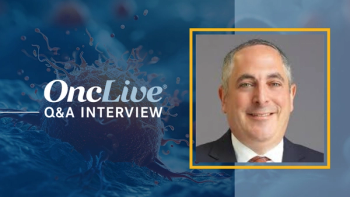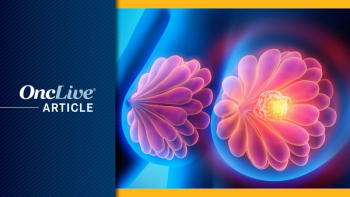
FDA Investigates Potential Increased Risk of Death With Umbralisib in Select Lymphomas
The FDA has announced that they are investigating umbralisib (Ukoniq), an oral inhibitor of PI3K-delta and CK1-epsilon that is approved to treat patients with marginal zone lymphoma and follicular lymphoma, after initial data from the phase 3 UNITY-CLL trial revealed a potential increased risk of death in those who received the agent.
The FDA has announced that they are investigating umbralisib (Ukoniq), an oral inhibitor of PI3K-delta and CK1-epsilon that is approved to treat patients with marginal zone lymphoma (MZL) and follicular lymphoma, after initial data from the phase 3 UNITY-CLL trial (NCT026112311) revealed a potential increased risk of death in those who received the agent.1
“Because of the seriousness of this safety concern and the similarities between the 2 types of cancer for which this drug is approved and the type of cancer that was studied in the clinical trial, we are alerting patients and health care professionals that we are re-evaluating this risk against the benefits of [umbralisib] for its approved uses,” according to the drug safety communication issued by the regulatory agency.
In the trial, investigators examined umbralisib in combination with ublituximab (U2) vs the active control regimen of obinutuzumab (Gazyva)/chlorambucil in patients with treatment-naïve or relapsed/refractory CLL.2Participants were randomized to 1 of 4 arms: ublituximab monotherapy, umbralisib monotherapy, U2, or obinutuzumab/chlorambucil. Investigators examined the contribution of U2 in the combination arm for the prespecified interim analysis and permitted the termination of the single-agent arms. The study continued enrollment in a 1:1 ratio to the 2 combination arms.
A total of 421 patients were included in the primary analysis of the trial. Those on the investigative arm were given oral umbralisib at a once-daily dose of 800 mg until disease progression or treatment discontinuation. Ublituximab was given intravenously (IV) at a dose of 150 mg on day 1, followed by 750 mg on day 2, and 900 mg on days 8 and 15 of cycle 1; day 1 of cycles 2 to 6, and on day 1 every 3 cycles following cycle 6. Those in the control arm received IV obinutuzumab at a dose of 1000 mg on days 1 and 2 (100 mg on day 1 followed by 900 mg on day 2), 8, and 15 of cycle 1; and day 1 of cycles 2 to 6. Oral chlorambucil was given at a dose of 0.5 mg/kg on days 1 and 15 of cycles 1 to 6. Each treatment cycle was 28 days.
The primary end point of the trial is progression-free survival (PFS) per independent review committee (IRC), and secondary end points included overall response rate (ORR) per IRC, complete response (CR), and safety examined from the first dose of treatment up until 30 days after the last dose.
Findings showed that U2 significantly improved PFS over the control regimen in those with this disease. The median PFS with U2 was 31.9 months (95% CI, 28.2-35.8) vs 17.9 months (95% CI, 16.1-22.6) with the control (HR, 0.546; 95% CI, 0.413-0.720; P < .0001). The 24-month PFS rates in the investigative and control arms were 76.6% and 52.1%, respectively.
Additional findings showed that U2 elicited an ORR of 83.3% (n = 210) vs 68.7% (n = 211) with obinutuzumab/chlorambucil (P < .001).3 Among those who responded to U2, 5% had a CR or CR with incomplete marrow recovery and 79% achieved a partial response (PR). In the control arm, 1% of patients had a CR and 67% had a PR.
Results also showed a potential increased risk of death in patients who received the U2 combination vs the control arm, according to the FDA. “Those receiving the [umbralisib] and the monoclonal antibody also experienced more serious adverse effects than those in the control arm,” the agency stated. “The UNITY trial was conducted in CLL patients, which is not an approved use but rather a use of this drug that is being studied; however, we believe these findings have implications for its approved uses for MZL and follicular lymphoma.”
The agency will continue to examine the results from the trial, and they may hold a public meeting to further discuss these data and explore the continued marketing of the agent. The enrollment of new patients to other ongoing trials evaluating umbralisib has been suspended as the investigation continues.
When the review is complete, the FDA will communicate final conclusions and recommendations regarding umbralisib.
Currently, the agency recommends that healthcare professionals review the progress of their patients who are receiving the agent and share with them the risks and benefits of continuing to receive treatment in the context of other available options.
Previously, in November 2021, the
Umbralisib: Approved Indications
In February 2021, the
The regulatory decision was based on earlier findings from the multicohort, open-label, phase 2b UNITY-NHL trial (NCT02793583), which enrolled patients who were at least 18 years of age and had a histologically confirmed diagnosis of B-cell indolent non-Hodgkin lymphoma.6 All patients had to have an ECOG performance status of 0 to 2.
Those with MZL needed to have received at least 1 prior line of therapy, which must have included at least 1 CD20-directed regimen, with failure to achieve at least a partial response or with disease progression following the most recent systemic regimen received. Those with follicular lymphoma or SLL had to have relapsed or refractory disease following 2 or more prior lines of systemic therapy, including an anti-CD20 monoclonal antibody and an alkylating agent. All patients needed to have evidence of 1 or more of the following features: bulky disease, high lactate dehydrogenase, B symptoms, threatened organ function, splenomegaly, cytopenias because of lymphoma, or effusions.
A total of 208 study participants (MZL = 69, follicular lymphoma = 117, and SLL = 22) received umbralisib at a once-daily dose of 800 mg as part of a 28-day treatment cycle. Treatment was continued until progressive disease, intolerable toxicity, or study withdrawal.
The primary end point of the trial was ORR, and key secondary end points included duration of response (DOR), PFS, CR rate, and safety. Time to response (TTR) was included as a post-hoc analysis.
The median age of patients was 66 years (range, 29-88), 56.7% were male, and 81.7% were White. Moreover, 51.0% had stage IV disease, 28.4% were refractory to their last anti–CD20-based therapy, and the median number of prior therapies was 2 (range, 1-10). Notably, 46.2% of patients received 3 or more prior therapies. All patients previously received ruxolitinib (Jakafi), and most had received anti–CD20-based chemoimmunotherapy. Moreover, 2.9% of those with MZL previously received a BTK inhibitor, as did 8.5% of those with follicular lymphoma and 22.7% of those with SLL.
At a median follow-up of 27.7 months, umbralisib elicited an ORR of 47.1% in the intent-to-treat population, based on independent review committee assessment. When broken down into subsets, umbralisib elicited ORRs of 49.3% (95% CI, 37.0%-61.6%) in those with MZL, 45.3% (95% CI, 36.1%-54.8%) in those with follicular lymphoma, and 50.0% (95% CI, 28.2%-71.8%) in those with SLL. The ORR was noted to be consistent across the 3 subtypes of MZL.
Moreover, 15.9% of patients with MZL achieved a CR to treatment, as did 5.1% of those with follicular lymphoma and 4.5% of those with SLL. The median DOR was not yet reached (95% CI, 10.3–not estimable [NE]) for those with MZL, 11.1 months (95% CI, 8.3-15.6) for those with follicular lymphoma, and 18.3 months (95% CI, 2.4-NE) for those with SLL. The median TTRs in these groups were 2.8 months (95% CI, 2.7-2.9), 4.6 months (95% CI, 3.0-5.6), and 2.7 months (95% CI, 2.4-2.8), respectively.
The median PFS was not reached (95% CI, 12.1-NE) in those with MZL, 10.6 months (95% CI, 7.3-13.7) in those with follicular lymphoma, and 20.9 months (95% CI, 7.4-24.1) in those with SLL. At 2 years, 50.5%, 18.1%, and 31.3%, of patients, respectively, were still free of disease progression.
Regarding safety, 99.5% of patients experienced treatment-emergent adverse effects (TEAEs), 53.4% of which had at least 1 grade 3 or higher effect. Grade 3 or higher TEAEs reported in 10% or more of the 208 patients included neutropenia (11.5%), diarrhea (10.1%), nausea (0.5%), fatigue (3.4%), vomiting (0.5%), decreased appetite (1.9%), dizziness (0.5%), headache (1.0%), insomnia (0.5%), peripheral edema (0.5%), alanine aminotransferase (ALT) increased (6.7%), aspartate aminotransferase (AST) increased (7.2%), and blood creatinine increased (0.5%).
References
- FDA investigating possible increased risk of death with lymphoma medicine Ukoniq (umbralisib). News release. FDA; February 3, 2022. Accessed February 4, 2022.
https://bit.ly/3L9QaHw - Gribben JG, Jurczak W, Jacobs R, et al. Umbralisib plus ublituximab (U2) is superior to obinutuzumab plus chlorambucil (O+Chl) in patients with treatment naïve (TN) and relapsed/refractory (R/R) chronic lymphocytic leukemia (CLL): results from the phase 3 Unity-CLL Study. Blood. 2020;136(suppl 1):37-39. doi:10.1182/blood-2020-134783
- Lunning M, Vose J, Nastoupil L, et al. Ublituximab and umbralisib in relapsed/refractory B-cell non-Hodgkin lymphoma and chronic lymphocytic leukemia. Blood. 2019;134(21):1811-1820. doi:10.1182/blood.2019002118
- TG Therapeutics provides regulatory update. TG Therapeutics. News release. TG Therapeutics; November 30, 2021. Accessed February 4, 2022.
https://bit.ly/3d6biPa - FDA grants accelerated approval to umbralisib for marginal zone lymphoma and follicular lymphoma. News release. FDA; February 5, 2021. Accessed February 4, 2022.
http://bit.ly/3aCBqQa - Fowler NH, Samaniego F, Jurczak W, et al. Umbralisib, a dual PI3Kδ/CK1ε inhibitor in patietns with relapsed or refractory indolent lymphoma. J Clin Oncol. 2021;39(15):1609-1618. doi:10.1200/JCO.20.03433

























































































